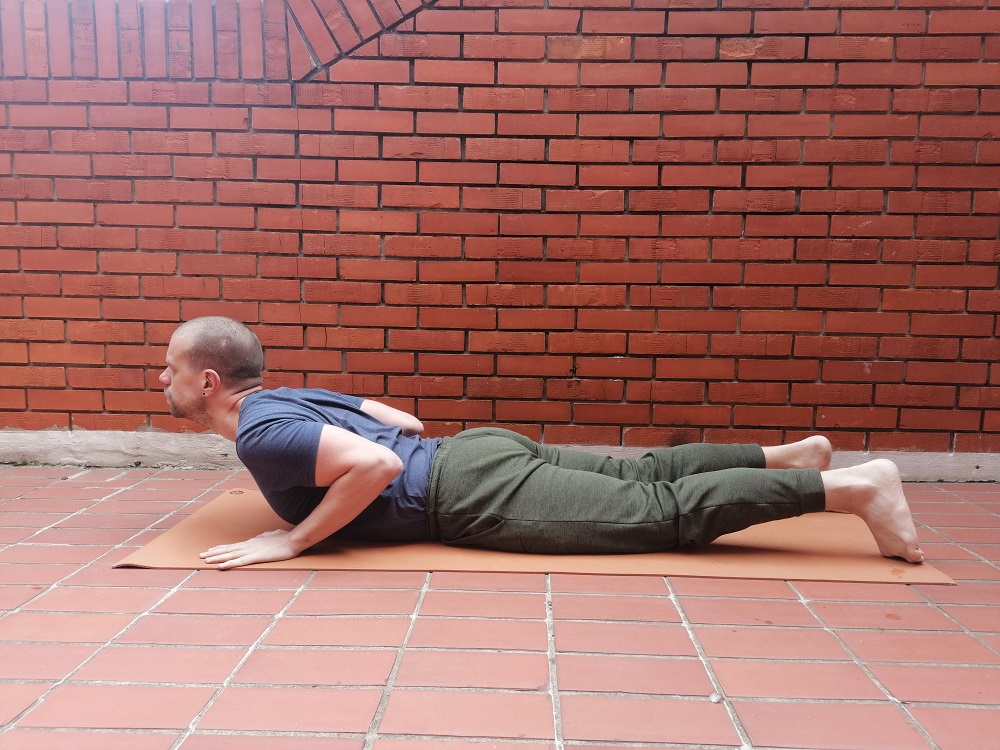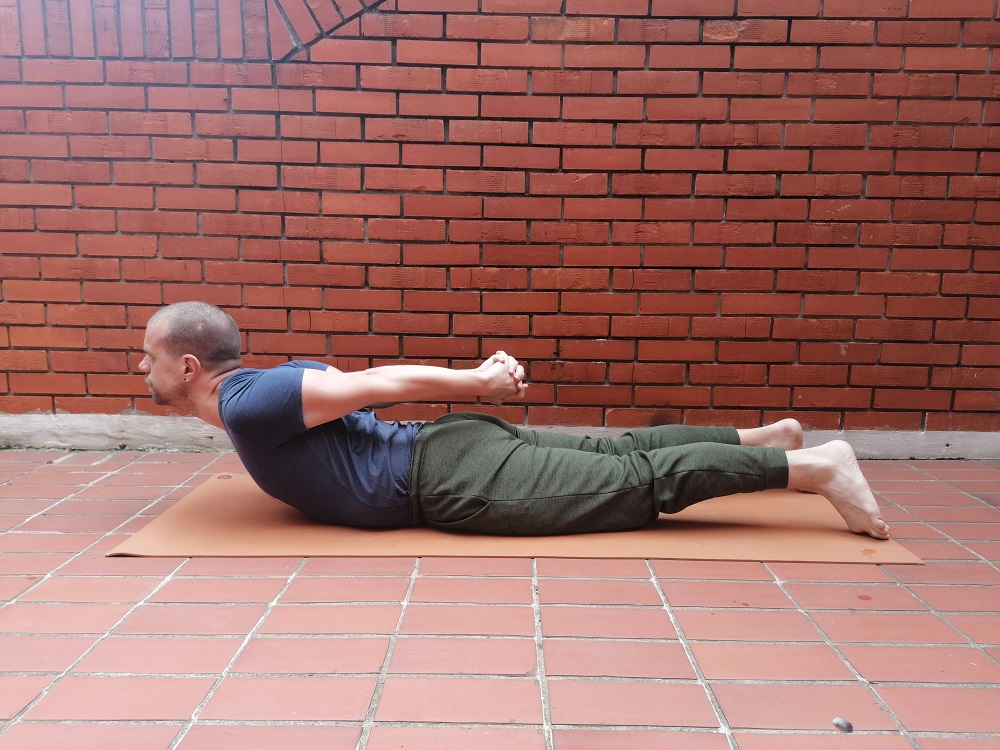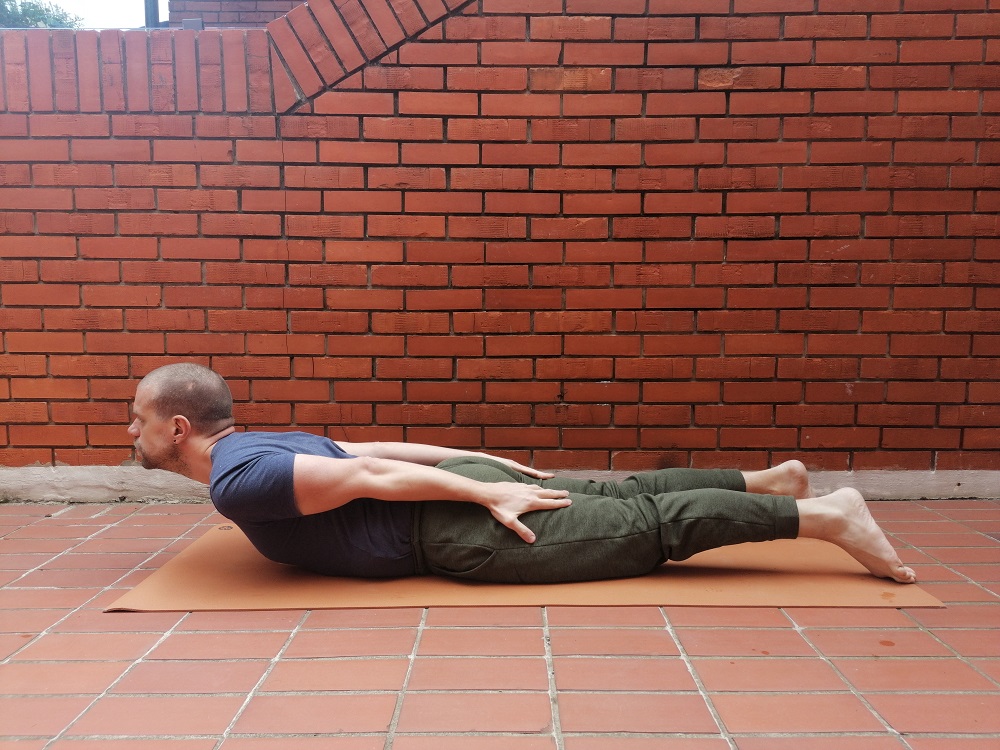“The Sanskrit name of the snake pose is Sarpasana. Sarpa, which means snake in Sanskrit, and asana, which means stance, are combined to form this word. The pose gets its name from the way the body is positioned in the final posture, which resembles an outstretched snake with its head raised.
If this is your first time discovering a snake pose, don’t worry! It will be simple after you know the right way to do it. This article will teach you everything you need to start with the snake pose, from the proper way to do it to the many benefits of practicing it. Let’s begin!”
How to do Snake Pose
Follow these simple steps to get into the snake pose:
- Start by lying on your stomach with your feet together and your arms at your sides.
- Place your palms at your side or behind your back and move your chest off the ground.
- Keep your head in a neutral position and look straight ahead.
- Slowly arch your back, letting your stomach sink towards the floor.
- When you have attained your full range of movement, hold the position for at least 30 seconds and, at most, one minute.
- To release the pose, slowly lower your back to the ground and rest in Shavasana for a few breaths.
Variations of Snake Pose
Snake pose can be a little difficult for complete beginners as it doesn’t take the support of your hands. Before slowly progressing into this pose, try the following poses and build your strength.
Cobra Pose
This is the perfect pose to start with if you’re a beginner, as it’s very similar to the snake pose. The only difference is that your hands are placed on the ground next to your chest instead of behind your back in the cobra pose.

Locust Pose
This is an excellent pose for strengthening your back muscles, which will come in handy when you eventually transition to the snake pose. To do the locust pose, start by lying on your stomach with your palms at your sides. Then, raise your head, chest, and legs off the ground while pressing your lower back firmly into the mat. Before returning to the beginning position, hold the stance for a period of 30 to 60 seconds.

Upward Dog Pose
This is another great pose for beginners as it helps to open up the chest and shoulders. With your feet hip-width apart and your palms on the floor, begin in the push-up position. Then, press your palms to lift your torso and thighs off the ground, letting your head and neck hang freely. Before you go back to the initial position, hold the stance for 30 and 60 seconds.

Yoga Flow
Try this simple yoga flow that incorporates downward dog, cobra, and locust poses to help you prepare for the snake pose.
Benefits of Snake Pose
There are many benefits to practicing the snake pose, including:
Strengthening the Spine
The snake pose helps to strengthen and lengthen the spine, which can help to improve your posture. The arms’ lengthening behind challenges the body’s equilibrium as the backbend is reversed.
On the other hand, the back muscles and the obliques pull the body back. This keeps it steady and balanced by keeping the core (abdomen), chest (breastbone or sternum), pelvis (ischium or hip bone), and shoulders (scapula) engaged.
As a result, this posture significantly affects the lower back as one learns to maintain it for longer. Despite the fact that there is a mild impact on the collarbone and neck, you should keep the neck relaxed.
Reducing Stress and Anxiety
The snake pose has a calming effect on the nervous system and can help to reduce stress and anxiety. This is because the pose helps to release back and shoulder tension while promoting deep breathing.
Improving Digestion
By rubbing the abdominal organs and activating the digestive system, the snake position can aid in better digestion. This is beneficial for those who suffer from constipation, gas, or bloating.
Increasing Flexibility
The spine and shoulders become more flexible when performing the snake stance. The pose is also an excellent way to prepare the body for more difficult backbends.
Improving Circulation
The snake pose helps to improve circulation by bringing fresh blood to the muscles and organs of the body. This can help to improve energy levels and promote healing.
Contradictions of Snake Pose
Although there are great benefits associated with practicing the snake pose, there are also some contradictions. If in case you have one of the conditions listed below, you should avoid the pose!
Back Injuries
The snake pose can aggravate back injuries as it depends on your back muscles to execute the pose correctly. If in case you have any of the following ailments, it’s best to avoid this pose or try other variations till you get comfortable with it.
Neck Injuries
The snake pose can also aggravate neck injuries, so it’s best to avoid the pose if you have any existing neck pain or injuries.
High Blood Pressure
The snake pose can increase blood pressure, so it’s best to avoid the pose if you have high blood pressure. Instead of helping you relax, the posture may increase your anxiety levels.
Pregnant
The snake pose should be avoided during pregnancy as it can stress the abdominal organs unnecessarily. Also, the posture can be dangerous if you’re pregnant and experience bleeding or miscarriage.
Senior Citizens and Kids
The snake pose is not recommended for senior citizens or kids as it can be too strenuous. It could lead to injury if you do not seek the help of a qualified yoga teacher.
Recovering From Surgery
The snake pose should be avoided if you are recovering from any kind of surgery, as it can put unnecessary strain on the body. If your wounds are healed, you may start practicing using props like yoga blocks or a strap to support your body. Most importantly, don’t bounce back to this pose without the supervision of a teacher.
Parting Words
The snake pose is an outstanding yoga pose for beginners as it helps improve flexibility and circulation while reducing stress and anxiety. If the asana is too strenuous for you at first, you should keep away from it. Before performing the posture, it is best to speak with your doctor if you have any other health issues.








